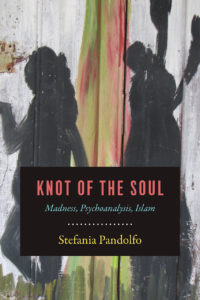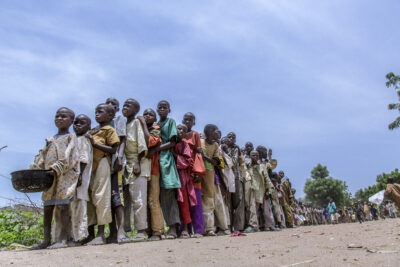 More than any other book I have read recently, Stefania Pandolfo’s Knot of the Soul made me ask myself time and again: How does this narrative of multiple encounters with patients and healers in Morocco, how does the ethnography presented here, how do the case studies and their intimate relation to the conceptual work, make me think differently? Or, to put it along the lines of her beautiful and often mesmerizing storytelling: How does this book make me think differently by listening differently? And how does it make me and us think differently about what we call “religion,” especially Islam, in the postcolonial present, when we pay attention to the ways of listening she asks us to engage in?
More than any other book I have read recently, Stefania Pandolfo’s Knot of the Soul made me ask myself time and again: How does this narrative of multiple encounters with patients and healers in Morocco, how does the ethnography presented here, how do the case studies and their intimate relation to the conceptual work, make me think differently? Or, to put it along the lines of her beautiful and often mesmerizing storytelling: How does this book make me think differently by listening differently? And how does it make me and us think differently about what we call “religion,” especially Islam, in the postcolonial present, when we pay attention to the ways of listening she asks us to engage in?
Indeed, Pandolfo’s book is first and foremost a deeply provocative presentation of voices, their resonances, and textures. It is also—and this is the moment where the question of thinking differently emerges—a book that makes sophisticated conceptual work converge with the questions that arise from the ethnographic description. What Pandolfo presents in a series of conversations and explorations with patients and healers is a drama that comes forth through the layers that organize the fields of utterances, and of the voices that encounter each other through these layers. Including both psychoanalytic and Muslim schools of engaging the life of the soul, both the setting of the clinic and the mosque, the psychological literature and the Qur’an, the book brings to life a postcolonial situation. There is no discourse about things, people, situations, presents, and pasts here, but a language that illuminates the complexity of temporal, spatial, and linguistic intersections as a complicated and utterly rich texture of conversations.
It is through these conversations that both the vocabularies of psychoanalytic and spiritual engagement take shape, never as instruments of analysis alone, but as languages that ask for translation time and again. These languages, which we tend to inhabit comfortably both on the psychoanalytic side and on the side of spiritual techniques, are reformatted incessantly in moments of abandon and exposure. They thus lose their pretentious stability and turn into places of ever new and, I am tempted to say, existential translations of psychic lives and their needs and desires for articulation.
As Pandolfo demonstrates, the specificity of the postcolonial situation—including the languages, landscapes, and architecture—is not an extraneous moment in this quest for translation, articulation, and listening. The specificity resides at its core, as does the language of the Qur’an that is at work through the healing practices of “the Imam” she has been working with, and as do the languages of colonial conquest, of education, of local tradition. What Pandolfo brings to our attention, then, is both the density of the encounters that comprise the postcolonial—including the rooftop as a place of conversation, the smell of the sea, the paces and moods that perspire—and the very richness that unfolds in her narratives which reestablish the weight of the voices we meet. Thus, what we call “illness” takes on a new shape. “By the end of that day,” she concludes one of the portraits (a case study in the context of the Imam’s healing practice), “the crisis of illness had disclosed itself as the enigmatic knot from which radiated the secret threads that connected the multiple lives of the family: present and past, potential and failed, impossible or unlived, with their desires and longings, their load of resentment and hope. Their threads and their parallel unfolding were made manifest and could be heard in the voice of the invisible entities with whom those lives intersected and exchanged their places, in the tangle of oppression, violence, desire, and companionship.” It all comes together, and it all gets untangled, not in a conceptual work, not in the superimposition of a voice, nor in the liberation of a voice, but in and under the constraints of the liturgy, “in the space of a struggle, inaugurated by the proclamation of the sovereignty of God.” In other words, it is the liturgy that provides “the syntax and the forms of an imaginal experience.”
The drama of discernment that emerges before our eyes in this book includes all the vocabularies that encounter each other here: the ethnographic narrative and description, the discourse of psychoanalysis and psychotherapy, the voices of the patients in different languages, the voices of the Qur’an, the Imam, and the medieval Muslim philosophers. The drama includes, as well, the landscapes, the sea, the very buildings where these voices appear, expressing a historical moment in the fullness and lack of its postcolonial articulation. Language and material worlds intersect, converge, and fall apart time and again, bringing to our awareness that not only the patients and the healers, but we ourselves, are made from all this. Pandolfo draws our attention to our involvement in an exemplary form.
In this regard, I found the instances and the significance of singing and chanting most fascinating and telling, both in the persons whom we call patients and in the person of the Imam. In these moments the physical textures we confront become most visible: the “culture in agony” and the “ruins of symbolic forms” that Pandolfo engages through the work of Frantz Fanon and Michel de Certeau; the healing voices of the therapists; and, finally, of the imam reciting the Qur’an over the body of a patient. His voice brings back the revelation and the sacred text not in form of “religion,” but of a liturgical practice that articulates the drama of voices, their multitude, and the needs of discernment through the reference to an imaginal space.
It would be too simplistic to speak of binaries (secular and religious, scientific and magic, et cetera) here and to think of these binaries as questioned or resolved. Instead, Pandolfo’s book opens a perspective of thinking of “reformed Islamic cures” in the context of an “Islamic revival” in a postcolonial situation as practices of transformation. These practices recall the imaginal real against the agony of ruined cultures not as a supplement but as the very constitutive moment that enables the interaction between the layers of voices that her ethnography uncovers. Thus, these practices also throw a different light on our understanding of the medical and psychoanalytic cures we are confronted with in this book. In their exposure to the patients in the specificity of the historical situations—and through the eyes and ears of the ethnographer—they turn into liturgical practices. This does not mean they lose their conceptual form. Instead, the conceptual takes shape in the conversations as a form of attentive listening that responds to specific needs, i.e., the need to find a form that responds to the fullness of the sensual and cognitive life of the soul.
Pandolfo states that on this basis “a conversation is possible between the ethics of psychoanalysis and ethics in the Islamic tradition.” Focusing on the three parts of her book, I think she does much more than that. Returning to the trope of thinking differently in listening differently, I want to foreground what Pandolfo’s book contributes to our understanding of “religion” in a situation where we want to acknowledge that speaking of “religion” in universalizing terms is meaningless. It is in this area where Pandolfo’s references to the voices and theories of Ibn ‘Arabi and al-Ghazali is most productive since they allow for the identification of what Pandolfo calls an “imaginal realm” and an “imaginal stage,” as well as a notion of dreams where “a site for an encounter with the divine, and the training of a renewed capacity to cultivate and host a divine gaze” emerge. As Pandolfo explains, the “contrastive dialogue between the psychoanalytic and the Qur’anic cure” thus opens “a spiritual-metaphysical dimension of the psyche itself.” Beyond this, however, the “spiritual-metaphysical dimension” is an aspect of life that—thanks to Pandolfo’s ethnography—must be seen not just as a dimension added under certain circumstances, i.e., something akin to a “religious” dimension. Instead, it turns into the very core of psychic life and its liturgical needs. It does so not as a matter of “belief” or “revelation” in and through the book, but as a sphere of resonance that has its origin in the life of the soul itself.
Relying on Pandolfo’s words we might call this “a topological elsewhere,” “an effect of withdrawal,” a mode “of breaking the ties with ‘home’ in all its forms,” and—alluding both to Gilles Deleuze and to Ibn ‘Arabi’s and al-Ghazali’s philosophy of the imagination—a “metaphysics of imagination.” Taking inspiration from al-Ghazali she writes: “Imagination is both a capacity and a modality of being.” It is this capacity that becomes visible not as a region apart but as the very sphere that holds the voices together, both in binding and in unbinding their articulations. Imagination gives shape to, or, maybe more precisely, establishes the ground for, the forms the voices take. Imagination also provides the space of resonance that makes listening possible at all. Thus, imagination allows for expansion and concentration, disfiguration and figuration, and ultimately the richness that discloses itself in the voices we encounter.
It is in these moments that we find answers to the questions with which I started. The “state of agony,” the “ruin of symbolic forms” that we see in and through the conversations with patients and healers turns, challenges our ways of thinking “religion.” We become aware that we misread what is at stake when we speak of a “religious dimension” of life. We discover the listening that subverts our conceptual work time and again.













